Canine Cancer - Part One
This article is the first in a series about cancer in dogs and will give an overview of the subject. Future articles in this series will review the symptoms, treatment, and prognosis of the most common types of cancer, home treatment for a terminally-ill dog, and basics of chemotherapy.
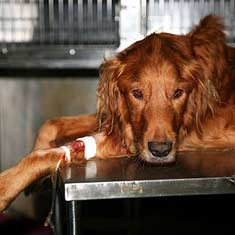
Ten Common Signs of Canine Cancer
According to the American Veterinary Medical Association, the following are the most common signs of cancer in a dog. Although any one of these alone may not mean that cancer is present, taken together, they can indicate a pretty convincing diagnosis.
First is an abnormal swelling that won't go away or that continues to grow. Many dogs who have skin cancers or cancer of the lymph system will show this as the first symptom. As you pet or groom your dog, you will feel lumps where there weren't any before.
The second symptom is a sore that won't heal, which could indicate a skin cancer.
Third is weight loss for which you have no alternative explanation. If your dog is overweight and you have put him on a strict diet and / or exercise program, obviously, you would expect him to lose weight. However, if you are not trying to get your dog to lose weight, and he does anyway, it may be a symptom of any number of diseases and should be investigated.
Fourth is loss of appetite. Most dogs will eat just about anything you put in front of them. If your dog is off his food for a day or two, he may just not be feeling quite right, but if he won't eat or doesn't eat his normal amount for days on end, you should probably have him checked.
The fifth symptom to be on the lookout for is bleeding or discharge from any body opening. For example, bleeding gums can indicate a blood disorder such as leukemia, while bleeding from the other end can indicate colo-rectal cancer.
Sixth is an offensive odor. Again, you must look behind the symptom to the cause to determine if you should be alarmed. If your dog has been rolling around in the carcass of something he found in the woods, all he needs is a bath. However, if the odor seems to be coming from the dog himself, you may have a problem.
Seventh is difficulty eating or swallowing. A dog who has swollen lymph nodes in the neck may not be able to swallow his food easily. In addition, a dog who has sore or swollen gums will also not be too excited about eating.
The eighth symptom to watch for revolves around exercise. A dog who is normally very active but has recently turned into a couch potato may have a problem. If you have a couch potato to begin with, obviously this will be a bit harder to detect. Even if your dog is willing to exercise, you may see that he is not able to do as much as he used to. This could be a sign of advancing age, or could be an indication that he needs to be checked by your vet.
Ninth, and somewhat related to the eighth, is lameness or stiffness. If your dog's limbs become sore, it may be due to bone cancer. You will notice that he hesitates to put his full weight on one of his legs or that he has trouble going up the stairs.
Tenth, and last, is if the dog has trouble with any of his normal biologic functions such as breathing or going to the bathroom. Some dogs such as pugs naturally sound like they are gasping for air because of their short noses. Again, you are looking for a change. If your dog normally breathes quietly and easily, but then begins having trouble, it is a sign that something is wrong. Similarly, if your dog begins having to strain to go to the bathroom, or produces blood in his urine or stool, it is reason to be concerned.
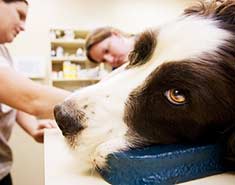
The biology of canine cancer
Under normal conditions, all cells in the body grow, divide, and die off under the control of the cells' DNA. The process of cell division is carefully balanced with the process of cell death, which basically prevents the dog from becoming a giant. When this process is disturbed in a particular type of cell, growth overtakes death, causing a tumor to form. Some tumors are formed of cells that still look pretty similar to the tissue from which they formed. These are called benign tumors and generally cause no harm to the dog, other than taking up space which would normally be occupied by the dog's organs.
By contrast, malignant tumors are composed of cells which are so damaged as to no longer be able to perform their original function. For example, a malignant tumor of the bone located in a dog's leg would not be able to support the dog's weight, causing pain in the leg. In addition, malignant cells are very aggressive and can travel throughout the body, forming more tumors through a process known as metastasis.
What causes a dog to develop cancer?
If anyone knew for sure what caused cancer, that person would be rich beyond belief. In reality, it is likely that there is no single cause, but rather a host of mechanisms that make cell division run wild.
Probably the easiest way to look at this is to think about cancer in humans. For example, we know that people who smoke often develop lung cancer. However, we also know that not all smokers will end up with lung cancer, while some folks who have never smoked will develop lung cancer. Therefore, we can say that smoking contributes to lung cancer, but does not cause it exclusively. There has to be other mechanisms that contribute as well.
What scientists have been able to determine is that there are certain things that seem to encourage cancer cells to grow. One of these risk factors is age. It appears that as we age, cell quality begins to degrade and can contribute to the formation of malignant cells. Other risk factors include genetics, viruses, and exposure to carcinogens such as the cigarette smoking noted above. There is no reason to think that the mechanism of cancer formation in dogs is much different than it is in humans; therefore, it is reasonable to assume that canine cancer is also the result of a number of factors such as genetics, age, viral exposure, and carcinogen exposure.
What does a "Stage" of cancer mean?
Tumors are classified by their stage as a means of indicating how advanced they have become. Generally, the stages run from State I, the least serious, to Stage V, the most serious. As an example, we can look at lymphoma, one of the most common tumors found in dogs.
- Stage I lymphoma indicates that only one lymph node is involved. The cancer is in a very early stage.
- Stage II lymphoma involves several lymph nodes, but they are all in the same general area, such as around the throat.
- Stage III lymphoma means that all of the lymph nodes located close to the surface of the skin are involved.
- Stage IV lymphoma involves all of the peripheral lymph nodes, as above, and has advanced to involve the spleen, liver, and lymph nodes located in the chest.
- Stage V lymphoma, the most serious, involves the peripheral and chest lymph nodes, the spleen, the liver, and the bone marrow.
In addition to staging, cancers are also graded to indicate their aggressiveness. In a lower grade tumor, the cells will look pretty much like normal cells, while higher grade tumors have cells that are massively different in appearance and behavior.
Taken together, the stage and grade of a tumor will help you and your veterinarian decide on treatment goals for your dog. Whether you decide to provide only pain relief or to aggressively pursue chemotherapy, radiation, and other therapies to restore full health to your dog, or to immediately euthanize the dog will depend a great deal on the results of a biopsy which will show the stage and grade of the tumor.
Check back in our article library often for future articles in this series on canine cancer.
Doggies Den: Latest Articles
 Homemade Thanksgiving Treats for Your Dog
Homemade Thanksgiving Treats for Your Dog
NUTRITION We all want to include our dogs in our holiday celebrations, but hopefully, you're aware that sharing table scraps with your dog isn't always the best idea.
 Keeping Your Dog Safe during the Summer Months
Keeping Your Dog Safe during the Summer Months
HEALTH Summer is coming on fast, so it’s time to plan how you will keep your dog safe and healthy through the lazy, carefree, warm days.
 Vaccination Time Again-Keeping Your Puppy Healthy
Vaccination Time Again-Keeping Your Puppy Healthy
DOG HEALTH So you have your new puppy picked out. There are quite a few shots, treatments and examinations that will keep the newest member of your family healthy.
 Canine Thanksgiving Feast
Canine Thanksgiving Feast
NUTRITION With the wide variety of food at Thanksgiving dinner, chances are you'll want to give your dog something special, too. If you're contemplating what to feed your dog for the holiday, here is a guide to a great Canine Thanksgiving Feast.
 Dog Walking Tips Every Owner Should Know
Dog Walking Tips Every Owner Should Know
DOG FUN Walking your dog is not only crucial to keeping him healthy and happy, it strengthens the bond between your canine friend and his caregiver. There are a lot of obstacles out there. Don’t forget these simple tips to keep your walk fun and safe in the outside world.
 The Benefits of Physiotherapy for your Dog
The Benefits of Physiotherapy for your Dog
HEALTH The same techniques that physiotherapists use to treat a variety of injuries and conditions in humans have been adapted to suit animals with great success. Family pets, show dogs, and working dogs can all benefit greatly from physiotherapy. Dogs whose activities involve a lot of agility are especially susceptible to the types of problems that physiotherapy can address.
 The Decision- Adding a Dog to Your Family
The Decision- Adding a Dog to Your Family
FIRST TIME OWNERSBringing a dog into your family is a decision where many people don’t realize it’s magnitude until after they have the dog. There are a number of things that you need to research before you decide to purchase a dog, and it starts right in your own home.
 Bringing Your Dog Into Your New Baby's Life
Bringing Your Dog Into Your New Baby's Life
HEALTH Many believe that a dog and a new baby cannot happily coexist, so therefore the dog has to go. This is not necessarily the case. A new baby does not mean you have to abandon your dog.

Doggies Den:
Most Popular Articles

Dog Pregnancy Symptoms
HEALTHIf you suspect your dog might be pregnant, check out part one in this series on pregnant dogs, where we cover pregnant dog symptoms.
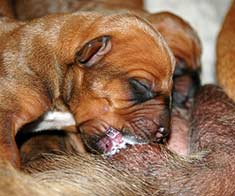
Dog Birth
HEALTHIn the third article of our dog pregnancy series, we look at the wonderful, but messy, process of bringing newborn puppies into the world.

Indoor Dog Potties
DOG PRODUCTSIt's been a long day at work. You were so busy, you didn't even take time to eat a sandwich, let alone run home to let your dog out. You're on your way home, knowing the poor dog is crossing his or her legs by now, when your car breaks down, delaying you even further. Can't somebody make this easier?
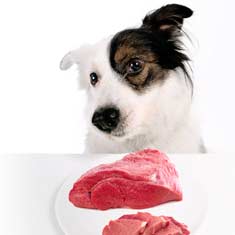
Your Dog’s Digestive System
PHYSIOLOGYEver wonder why your dog eats so fast? Or why he eats gross things? Or why he gets sick to his stomach? Or why his waste stinks so bad? Some of these things are normal, some are not.

Canine Respiratory System
BREATHINGThe basic function of your dog's respiratory system is to bring oxygen in to and remove carbon dioxide from the body. Knowing the symptoms of respiratory diseases can help you help your stay healthy.
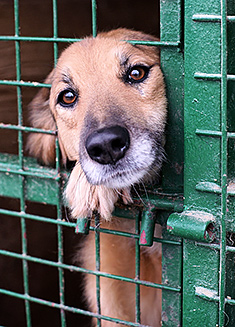
Shelter Dog Adoption Tips for Success
ADOPTION Are you intimidated by the prospect of "rescuing" a dog from a shelter? One reason that you may be wary of adopting a dog from a shelter is not knowing how to choose. Adopting a dog from a shelter can be a rewarding process, if you're prepared to do a reasonable amount of research.

Canine Urinary Tract Infections
SYMPTOMS AND TREATMENTDoes your dog seem to be having trouble relieving his or her bladder? Learn how to recognize the signs of urinary tract infections and how to treat them before they spread.

What to do for Dog Diarrhea
SYMPTOMS AND REMEDIESIf you have dogs in your house for any length of time, you have likely experienced at least one bout of dog diarrhea. Beyond the pain in the tuckus involved in cleaning up the mess, you should know what causes diarrhea, and when it's important to see the vet.
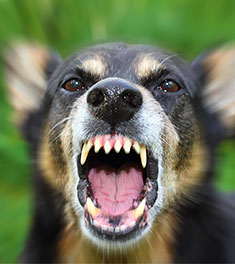
What to do for a Dog Bite
DOG BEHAVIOR Getting bitten by a dog can be scary, and you may be tempted to run around in circles for a while, trying to figure out what to do. Here's our guide to help you manage the situation.

Top Ten Tips for Living with a Senior Dog
DOG HEALTH Bringing home a new puppy is so exciting, but it doesn’t take all that long for your exuberant puppy to grow into a senior dog who may have special needs. Here are the doggies.com top ten tips for taking care of your companion who has been with you through so much.
